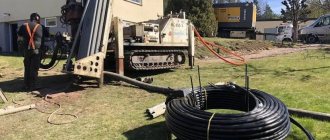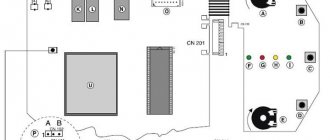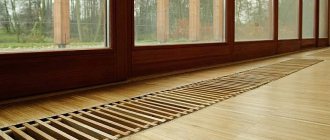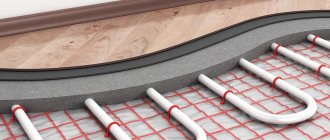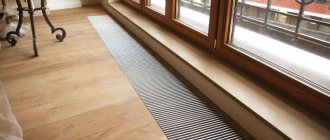If we decide to have animals at home, then we are obliged to take care of them. Cats live next to their owner. There are dog breeds that also live in the house. At the dacha, the dog is kept to guard the area and lives in its own separate room. How to protect your animal from freezing during the cold season? Our article contains information about the dog house heaters used.
To organize heating of the booth, it is necessary to bring the electrical network closer and install a closed socket.
Insulated and heated dog house
Friends, today we have an unexpected, but very interesting topic related to our smaller brothers.
At first glance, film electric heaters and the type of activity of our company, which deals with heating systems, have no direct relation to dogs. But this is not the case, as you can see by reading this article, prepared based on questions from our visitors. For example, is it possible to put film in a doghouse to keep it warm? Of course yes! And today we’ll talk about how to do this correctly and effectively. Questions about how to insulate a dog house are quite natural and logical. Our specialists are asked these questions almost every day. However, before heating the dog house, you should take care of its insulation. Therefore, we share with you the real experience of our employee. Meet this cute dog named Pepsi !
In the summer of 2014, she nailed herself to a garage that temporarily replaced an outbuilding on a summer cottage. There were no more buildings in the field then.
The dog was very thin and whined constantly. We adopted her and gave her the nickname Pepsi. The dog was young, only 7-8 months old, and recovered very quickly, finding its home, becoming very lively and cheerful.
She spent the summer hiding under the garage from the intense heat, and felt quite comfortable. And by autumn we put together a booth for our pet. It looks like the most ordinary one, but well insulated from the inside.
For insulation, 50 mm thick penoplex . It not only has minimal thermal conductivity, but is also not afraid of dampness and water getting on the surface.
We insulated the walls and ceiling all around from the inside, and the floor from the outside. At the entrance, they attached an ordinary rug, which protected Pepsi from direct drafts (an ordinary tarpaulin can also be used for this purpose). All the cracks of the insulated dog house were filled with polyurethane foam from the inside and outside, so it turned out to be very warm. We visited Pepsi every day and she felt absolutely comfortable even in the harsh Ural winter. Pepsi warmed herself ! Her own heat was enough to create an optimal temperature inside the booth (by the way, normal body temperature in dogs is 38.5-39°C).
We did not measure the actual air temperature that was in the booth. But when it was -30 Celsius outside, you could warm your hands inside! This effect was achieved thanks to excellent thermal insulation using 50 mm thick penoplex. At the same time, the insulated dog house stood in an open place in the middle of a field - there were no fences or other shelters from the wind, only a garage 2 meters away.
It was here, in her warm, comfortable booth, that Pepsi gave birth for the first time, bringing with her three large “chipmunks.”
And for two winter months with severe frosts, they practically did not leave the booth, which is quite understandable - it was dry and very warm there. After the puppies grew up, we gave them into good hands, and to this day they delight their owners.
By the way, we want to take this opportunity to thank all the people who did not remain indifferent to the fate of Pepsi and the puppies. Every day someone fed them, as a result the puppies grew up healthy and cheerful. Thank you all so much !
Choosing heaters for the utility room
Due to their excellent efficiency, film heaters are widely used in the market today. They are economical and consume minimal energy. At the same time, thanks to the use of modern technologies, they perfectly heat the room without leading to the appearance of dry air. The use of such film heaters does not present any difficulty. You just need to plug in the device, after which it will immediately begin heating the room.
Here you can choose various models of such film heaters, which differ in their power ratings. With equal success, you can choose models designed for booths with an area of several square meters, as well as for rooms with an area of 10–20 square meters. We offer high-quality heaters at low costs.
Many happy owners of their dogs are concerned about protecting their pet from the cold. How to make the temperature in the booth comfortable when the air temperature outside is below zero? We offer a unique solution to this problem - a panel heater for the booth!
The dog house heater works on the principle of thermal radiation, in which first of all, not the air, like other heaters, is heated, but directly objects and animals.
An important factor is safety: the booth heater has a high degree of fire and explosion hazard, as well as a high degree of moisture resistance (degree of protection - IP66)
Having a low surface heating temperature (about 50 °C), such a heater does not burn air, which is very important when used in a small room. And of course, the aesthetic appearance of the heaters will delight you with its thinness, only 2 cm! Installation is carried out using 4 self-tapping screws
We also offer a service for installing a heater inside an existing booth - installing a heater in the booth
And of course, the aesthetic appearance of the heaters will delight you with its thinness, only 2 cm! Installation is carried out with 4 self-tapping screws. We also offer a service for installing a heater inside an existing booth - installing a heater in the booth.
Heaters are available in several sizes:
| Heater dimensions, cm: | ||
| 59x59x2 | 96x52x2 | 62x37x2 |
| Power, W: | ||
| 250 | 250 | 200 |
| Weight, kg: | ||
| 5 | 6 | 4 |
| Price, rub: | ||
| 8000 | 9000 | 7500 |
If you want to set the desired temperature in the booth, we offer you a thermostat for a mechanical heater. It will not only create and maintain a comfortable temperature, but also reduce energy consumption.
To protect the thermostat from curious dogs, a metal protective box with a lock is provided.
Source
Pros and cons of an insulated dog house
But let’s return to our topic and see what happened to our booth during the winter season, let’s look at all its pros and cons . The first thing we noticed was that it turned out to be a good “thermos”, the heat losses of which turned out to be minimal. And these minor losses were perfectly compensated by the dog with the warmth of its body (well, the puppies also helped a little).
Back then, no one thought about installing heating in a doghouse. Moreover, they did it in the fall in relative haste, so they didn’t even line the foam interior with anything. For this, you could use anything: plywood, boards, osb or mdf boards, and other materials. And this is what happened as a result.
We see that the insulation in places of intense contact and constant friction of animals has crumbled. And the puppies also contributed when they bit off or scratched out pieces during their games. Therefore, to ensure durability, it is advisable to hide even such dense insulation as penoplex from dog claws and teeth. And in those places where contact between dogs and the material was absent or minimal (for example, on the ceiling), penoplex looks like new.
But in the summer we learned that our wonderful booth had a significant drawback. Pepsi gave birth again this summer. And in this litter there were already six beautiful puppies.
The sultry heat turned the warm booth into a real sauna. After all, in addition to the entrance, it turned out to be absolutely sealed and did not even have any cracks for the flow of fresh air. The situation was saved by the fact that the design of the booth included a roof that could be raised. This allowed for a slight draft, but it was still quite hot throughout the summer.
The conclusion suggests itself is that when designing an all-season booth, it is imperative to provide removable insulation. The same penoplex can be removed from the walls, and the roof can be raised for ventilation. As an option, you can make a booth for your pets in an enclosure or a booth with an open, uninsulated veranda and an opening roof (as in the picture below).
Such a booth will provide excellent protection from the sun and provide a draft.
In our case, too, everything ended well. The puppies, like Pepsi, escaped the heat in the coolness under the garage, almost without going into the kennel. They have grown up well and today all six are in the good hands of their new owners.
Peculiarities
Those dogs that live in an apartment with their owners throughout the year often do not have their own house; they only need a specific place, a rug or soft bedding for sleep and rest. Due to prolonged living at home, dogs' fur becomes less thick and the undercoat completely disappears, so in winter it is not very comfortable for animals to be outside.
Good owners try to help their pet and insulate their house as much as possible during the cold season. A warm dog house will give you the opportunity to go through the entire cold season without any health problems for your pet. For those who are planning to insulate a house for a four-legged friend for the winter, you need to find out what materials and technologies may be required for this.
How to make an insulated dog house with your own hands
We once again focus your attention on the fact that for a healthy dog in winter it is enough to just insulate the booth well and foam all the cracks and joints. This will reduce heat loss so much that the dog will have enough heat from its own body to warm itself, that is, it will warm itself. In most cases, additional heating of the dog house For those who consider this insufficient, who want to protect their pets 200% from extreme frosts, there is an excellent solution. These are film electric heaters.
Mineral wool
If the booth is large or the winters are cold, you need to consider other insulation options. A forum participant asks the following question: “Tell me, what is better to insulate the booth: with mineral wool or polystyrene foam? The size of the booth, based on the size of my Bonnie, turns out to be impressive (St. Bernard girl).”
An excellent option in this case would be mineral wool. This is an environmentally friendly, non-flammable material, characterized by a low ability to transmit heat. This is a hygroscopic material, so fungus and mold do not grow in it.
The only drawback of this material is its soft structure. It needs to be covered with a sheet of moisture-resistant plywood. You need to use basalt wool. Glass wool is not suitable for these purposes.
To avoid shrinkage of the material, it is better to buy solid varieties of stone wool. They are sold in slabs, not rolls. This insulation will last for many years. Moisture-resistant plywood will not allow liquid to reach the cotton wool. All joints must be treated with acrylic sealant.
Expanded polystyrene is not suitable for insulating a booth, just like polystyrene foam. This is a synthetic material that can release harmful chemical compounds during operation. Therefore, the dog will most likely refuse such housing.
How to avoid frying your dog on the “warm” floor of a doghouse
I made a regular booth for my dog (German), with insulation. The entrance hole (height of the hole = height of the dog's withers) has curtains made of tent tarpaulin. The floor is insulated with foam plastic. The dog liked the booth right away! Before I even had time to finish the construction, he had already climbed in there and laid down!-)). He has already lived in a booth for 2 winters. It does not require heating-))).Before this, I laid different rugs on it. In the morning they were always lying on the street-)). He threw them out!
Py.Sy. Another important point: when I was looking for how to determine the size of a kennel for a specific dog, I saw many clarifying points, in particular: the absence of a draft is very important for a dog. Those. the booth must be made neatly and without cracks.
Py.Sy. Probably wood is still better as a material for building a booth, PMSM.
And if the booth is cramped, then it turns out like this:
So I scoured the Internet and found how to determine the size of the booth according to the size of the dog. This is how the dog’s house turned out
Thanks for the compliment -))). Made it myself!
Py.Sy.Yes, comfort in a kennel is important for a dog. And therefore, the house needs to be built to size. There is information on the Internet on how to measure a dog and get the dimensions for the kennel. That’s what I did.
Py.Py.Sy. By the way, here is the booth in the process of production-))))
The dog already likes her-)))
There is no need for heating in the booth - none. neither on the wall nor under the floor. This is bad for the dog's health. I don’t have this practice, but in all the books they write that the dog’s place should be away from heating devices and not in drafts. Temperature changes have a bad effect. But many of my friends have experience (repeatedly) of keeping chickens in an enclosure. All the descendants of my male dogs were kept in the yard since childhood. This is the mentality of villagers - they won’t let a dog into the house. The booth should be very warm, with foam, etc. Do not put any rags inside. The rags become damp and the dog throws them away. not because it’s hot, but because it’s damp. Hang a tarpaulin (for example) at the entrance to the booth to prevent the wind from blowing. You can also have a booth with a vestibule (as in the example above). In winter, don’t lock the enclosure—don’t limit its walking, let it wander. And one more thing - the dog is transferred to an kennel in the spring. Over the summer, having shed, in the fall (towards winter), with a gradual daily decrease in temperature, the undercoat grows - the Kurts have a very dense one, similar to batting - and the dog successfully winters in the kennel. And you translate in late autumn - the dogs may freeze.
Preparatory work
Before you start insulating the booth, you need to pay attention to such important points as:
- The entrance to the booth should be located where the movement of wind and draft is minimal;
- To avoid the penetration of excessive dampness into the kennel from the floor, the dog house should be installed on a hill, and if there is none, then on supports, like on stilts;
- You should not install the kennel in a heavily shaded place, but also not in the sun;
- If the size of the booth is significantly larger than the dog itself, then its heat may not be enough to heat the entire internal space, so it will be better if the dog’s apartments are 10-15 centimeters larger than the dog in any position;
- Build your dog's home exclusively from wood and avoid creating cracks and holes through which heat will escape.
Basic recommendations for keeping a dog on the street
Only a few breeds of tailed animals can withstand winter frosts without any problems: huskies, huskies, malamutes, Central Asian and Caucasian shepherd dogs. But even for the most frost-resistant dogs, not to mention the rest, it is necessary to prepare a booth that protects from frost and wind. Not just a wooden frame.
In rooms where dogs are kept during the cold season, it is advisable to maintain the air temperature at about 15-16°C. But drafts and excessive heating are undesirable! Sudden changes, when an animal jumps from 25°C to minus street temperatures, can easily provoke illness.
We will “dance” around these recommendations.
First of all, by determining the optimal dimensions of the booth. On sale you will find standard “houses”, often measuring 0.5x1m. But it is better to focus on the specific height and weight of your pet.
The bigger the dog, the bigger the house
It is important to achieve a golden mean here:
- too tight is uncomfortable and restricts movement;
- If it is too spacious, it is more difficult to warm up from the dog’s own body temperature and its breathing. In an unheated booth, this is the main source of heat, and more energy is spent on heating excess space;
- If you are planning to move in a puppy, consider the size of the house for growth.
General recommendations are as follows: the dog should freely enter the booth in order to at least calmly turn around inside and lie down. Add 10-15 cm from the size of the animal for all dimensions of the room.
Drafts are extremely undesirable for a pet. Therefore, it is advisable to equip the entrance hole for the winter with weighted curtains (for example, made of tarpaulin).
Ready-made solutions are also suitable - for example, silicone blinds. The “correct” height of the entrance hole is equal to the height of the dog at the withers, the width is the size of the sternum plus 5 cm.
But these recommendations should be strictly adhered to, first of all, in the case when the booth is not heated additionally.
And if you decide not to leave your dog alone with the coming frosts (which is especially humane for short-haired breeds) and take care of heating, you can make the dog’s apartment more spacious.
Preliminary preparation
If a dog lives outside all year round, then by winter the animal grows warm fur that protects it from frost. Pets that are not accustomed to such changes will not be able to quickly adapt to new conditions. Prolonged exposure to the cold will negatively affect health, so the booth needs to be heated.
The design should be comfortable and fit the size of the dog. A house that is too spacious or too cramped will not provide favorable conditions in cold weather. 10-15 free spaces are left between the tenant and the walls.
Before heating the booth, the structure must be positioned correctly. When building a structure from scratch, you need to provide a foundation. The finished housing is placed on supports (wooden blocks), protecting the bottom from contact with the cold ground. This technical technique will protect against rain and snow getting inside. The optimal distance from the soil is 10 cm. If the space under the house is empty, then it is recommended to fill the free areas with insulation (foam plastic, mineral wool).
How to simply heat the floor in a booth
Perhaps the most progressive, safe and reliable way to supply heat to a dog’s home is floor heating.
For frost-resistant breeds, heated floors can be turned on not for permanent operation, but only at a significant disadvantage: when high humidity, chilly wind and frost bother them. Or to dry the booth.
You can organize floor heating using a special cable, ready-made mats or infrared heating film - everything is the same as in humans.
Each method has its own specifics.
Heating cable for a stationary booth
The best option is when the booth is designed to last for years, and not for one season.
Installation is simple. Lay 3-5-7 meters of heating cable in a snake in increments of 5-6 cm to 10-15 cm - in accordance with the instructions. Make sure that the cable is not kinked. Then secure it with plastic mesh and fill it with screed.
On dog lovers forums, there are opinions that it is better to take a self-regulating heating cable. They say it’s more convenient that it functions without a thermostat.
The advantages of this solution: yes, indeed, you can save on buying a thermostat.
But the disadvantages are also significant: you do not have the opportunity to influence the microclimate in the booth. And a regular heating cable is much cheaper than a “smart” one - the savings are debatable.
Automation of heating
In the normal physiological state of a dog, its body temperature ranges from 37.5 to 39°C. It is reasonable to set the floor temperature a degree or two lower. At the same time, make sure that it is not too hot in the booth - maximum 15°C (we have already said that the animal’s own warmth will add heat).
In order to maintain the temperature at a given level or make operational changes, you will have to buy a special thermostat for heated floors. In an online store (important: specialized ) you can select regulators yourself or ask one of the specialists to help. For example here in AxiomPlus (Kyiv, Ukraine)
The main thing is to choose the simplest and most inexpensive mechanical . Often it comes complete with a temperature sensor. Terneo RTP is often recommended.
A remote temperature sensor will measure its actual values. Before installing it in the floor, place the sensor in the corrugation. If it fails, you can quickly and without much difficulty remove the sensor and replace it with a functional one.
IR film for wall or ceiling
There is an opinion among dog lovers that it is better to make one or a couple of walls of the kennel warm, not the floor, by placing infrared heating film on them. They say, give the animal a choice - to lie down near a warm wall or, conversely, near the entrance, closer to fresh air.
In fact, this is not important, since according to the laws of physics, warm air inevitably rises, and it will still not be possible to directly warm the sides of the animal against the wall. But if you still choose this option, place the film under the inner lining to avoid damage to the heater by animal claws. And even better - under the ceiling of the building.
Methods for installing panel and film heaters
Manufactured heaters can be installed inside the frame of a dog house.
A layer of mineral wool is attached to the outer skin, and then a reflective screen. A film or panel heater is attached to it for the dog in the kennel with the working surface towards the inner lining, and then the lining itself is nailed. The panel heater can be installed on the wall of the booth. For such an installation, you need ordinary self-tapping screws, which attach the device directly to the wall.
To reduce energy consumption and easily regulate the heating temperature in the booth, it is advisable to buy a thermostat. To protect the device from the dog's teeth, you need to install a protective metal box with holes.
Power cable and circuit breaker in the panel
To power the system with electricity, a cable (for example, PVS or VVG brand) will have to be run through the air or in the ground across the yard. Moreover, the wire must be hidden in the pipe, and its choice depends on the drawing method.
In the case of overhead wiring, choose a pipe made of HDPE or polyamide that is resistant to UV radiation and temperature changes. You can bury the cable in the ground in a special red double-walled polyethylene pipe, or save money and choose a regular water supply or technical polyethylene pipe.
At what depth to lay the cable: in theory (according to GOST recommendations) - 1.2 meters. In practice, in a private yard, as a rule, they do not dig so deep.
How to choose cable cross-section
The easiest way is to use the following simplified empirically derived dependencies:
- cross section × 10 = maximum current (in amperes)
- amperage × 220V = power (kW)
Therefore, knowing the power of the floor heating system in the dog house, you can easily determine the required wire cross-section.
First, look at the passport of the heating cable to find out its linear power (in W/m). To determine the total power, we simply multiply the found indicator by the actual number of meters.
For the above cable, a piece of 9 meters from Gray Hot, the total power is indicated and is 129 W, or 0.13 kW.
Using this formula, we determine the maximum current:
0.13kW / 220V = 5.91A
Therefore, the conductor cross-section:
5.91/10 = 0.59mm². Let's round it up and get 0.75mm².
Or, in the case of a ready-made mat:
for the above-mentioned Gray Hot 0.5x1.2m, the total rated power is 92W. Let's round it up to 100W for ease of calculation.
In this case, with a load of 0.1 kW, amperage = 0.1 kW/220V = 4.55A.
Cross section = 4.55A / 10 = 0.45mm². - i.e., choose 0.5mm².
We calculate the rating of the “machine” for cable protection
Please note that to protect against possible emergency situations (overload currents or short circuits), you need to install a separate circuit breaker “on the booth” in your home electrical panel.
Its rating is selected based on the maximum load of the system section. Let us illustrate for our example with a heating mat of 0.1 kW and a maximum current consumption of 4.55 A.
To determine the rating of the circuit breaker, it is necessary to add a margin of 15-20% (no more to ensure adequate operation):
Next, go to the online catalog and choose the closest nominal (only up!) “automatic machine” - in our case it’s 6A. Prices, as you can see, are quite affordable - from 40 UAH.*
How else to help your pet easily cope with the cold season
Remember: no matter how reliable you make the floor heating, so as not to throw money away, do not ignore measures to insulate the building.
Thermal insulation of walls . Use polystyrene foam with a thickness of 0.5 cm or rolled thermal insulation materials (polyethylene, penofol). They are cheap, easy to attach, but require additional sheathing with plywood or OSB board to protect them from the claws and teeth of a four-legged resident. A good option is upholstery with felt; for this you only need nails with large heads. Glass wool should not be used ; it is harmful to the health of the animal.
Reliable roof . Everything is clear here - no gaps! Rain or melt water easily flows through them.
And also adjust your diet . It should be warm and satisfying. Please note: it is not the frequency of feedings that needs to be increased, but the calorie content of the portion.
How to close the walls
It will be hot in the booth, completely insulated from frost. The design must have natural air exchange. Large cracks in the kennel are sealed with pieces of fabric or filled with foam. Polystyrene foam (foam styrene) is an excellent insulation material, but if fully lined, the dog house will no longer allow oxygen to pass through and will become stuffy.
Felt
A natural, wear-resistant material with a warm surface is suitable for finishing walls and bottoms. Safe raw materials “breathe” well, so after heating the booth, the air inside will not be burned out. Felt cut into pieces is nailed to the internal partitions using a furniture stapler, and a curtain is made at the entrance.
Minvata
High-quality thermal insulation material does not burn and retains its original characteristics for a long time. Mineral wool is afraid of moisture, so when insulating the house it is necessary to protect it from precipitation. The raw materials are placed between the walls, securely covered inside and outside with plywood. To prevent water from leaking into the insulation, the corners are filled with acrylic sealant.
Thermal insulation in rolls
For a material based on foam rubber, one side is covered with a thin layer of foil. Raw materials are used to fill the empty space between the walls. The thicker the finish, the better the thermal insulation properties. The heated booth will maintain a pleasant temperature even in severe frosts.
